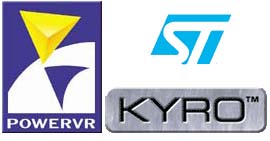Imagination Technologies / STMicro PowerVR Series 3: KYRO
by Michael Andrawes on June 7, 2000 11:27 AM EST- Posted in
- GPUs
Introduction
 When
things are going crazy in your life, taking a step back for a moment to reevaluate
everything can often be the key to a revlation that solves some of those problems.
The same concept can be applied to all walks of life and any circumstances.
When
things are going crazy in your life, taking a step back for a moment to reevaluate
everything can often be the key to a revlation that solves some of those problems.
The same concept can be applied to all walks of life and any circumstances.
In fact, the same can even be said about technology. After all, this is the way most revolutionary products have come about. Take a look at RISC CPU's for example. In the mid 80's, RISC technology was developed by a bunch of grad students who took a step back to find a more efficient way to design a CPU. In only a few months of development, they were able to surpass the performance of the most complex CISC machines available from all the big CPU manufacturers and their huge R&D budgets. Today, just about every new CPU is RISC based, or at least very RISC-like internally.
There are numerous examples throughout history and you can even see companies that are taking that approach today in the computer industry. While some of these crazy ideas will fail, and thus be forgotten, others will provide the big break throughs for the 21st century. Transmeta believes they have a unique way to design a CPU that gives great flexibility and performance for today and tomorrow. Rambus believes their RDRAM technology can overcome bottlenecks they see on the horizon with current memory technology. Who knows if we'll even remember Transmeta or Rambus if they fail, but if they succeed they will definitely not be forgotten.
Interestingly, 3D acceleration has remained relatively unchanged at its root for quite a while. Sure 3D acceleration has gotten faster thanks to clock rate increases and parallel pipelines. True we've constantly moved more of 3D pipeline into hardware and left less for the CPU. But the same basic rendering process has been in place since the 1960's, although back then it took a building filled with room-sized computers days to calculate a scene that current accelerators render at a 100 frames a second with ease.
Nevertheless, the pipeline is basically the same and we're beginning to run into the limitations of the current 3D rendering process. Take a look at the GeForce 2 GTS - we've shown clearly in our Overclocking the GeForce 2 GTS Guide that the core clock increases we are able to acheive today are quickly outstripping the memory bandwidth available with today's technology. While tomorrow's memory technology, whatever that may be, will certainly help, improvements to the core are happening at a much more rapid pace.
The time is right for someone to step forward with something revolutionary, and the first one to do so successfully may well take over the consumer 3D market if others don't catch up quickly. Imagination Technologies and STMicro believe that the solution is tile rendering. Tile rendering is at the heart of their new chip, the PowerVR Series 3 dubbed KYRO.










1 Comments
View All Comments
Lanning Donald - Saturday, March 28, 2020 - link
Reading these specifications of KYRO has made me so much interested in purchasing and using this technology for the commercial purposes. I have visited https://legitimate-writing-services.blogspot.com/2... site to get paper writing help and now I am hoping to reap out some fantastic benefits after using this technology.